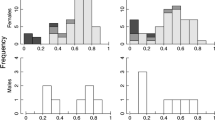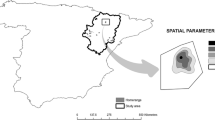Abstract
We tested several hypotheses to explain low between-year territory fidelity in a breeding population of yellow-headed blackbirds (Xanthocephalus xanthocephalus). During a 5-year study the population of territorial males declined by two-thirds and some of the marshes that supported territories significantly deteriorated. Individual males held territories and bred for an average of 1.9 years. Of males that bred for at least 2 years, 30% skipped owning a territory in the study area during at least 1 year of their breeding lifetimes. Our information suggests that they may have bred outside of the area in those years. Of males with territories in two or more breeding seasons, 60% changed breeding marshes at least once. Males changed territories during 42.9% of between-year opportunities to do so. We found no support for the hypotheses that male yellow-headed blackbirds: (1) are more likely to move when territory density is low; (2) are likely to abandon territories that are deteriorating; or (3) change territories to improve their reproductive success. We suggest three non-mutually exclusive explanations for the yellow-headed blackbird's weak site fidelity: (1) it is a response to habitat deterioration and to other factors that may be causing the population's decline; (2) the males, being migratory, make fresh settlement decisions each year after they arrive on the breeding grounds in the general vicinity of their previous year's breeding; (3) yellow-headed blackbirds may have evolved in, and be adapted to, highly unstable habitats, moving frequently in response to changes in local breeding site conditions.
Similar content being viewed by others
References
AOU (1957) Check-list of North American birds, 5th edn. American Ornithologists' Union, Ithaca, NY
Beletsky LD, Orians GH (1987) Territoriality among male red-winged blackbirds. I. Site fidelity and movement patterns. Behav Ecol Sociobiol 20:21–34
Beletsky LD, Orians GH, Wingfield JC (1990) Steroid hormones in relation to territoriality, breeding density, and parental behavior in male yellow-headed blackbirds. Auk 107:60–68
Dobson SF, Jones WT (1985) Multiple causes of dispersal. Am Nat 126:855–858
Gavin TA, Bollinger EK (1988) Reproductive correlates of breeding site fidelity in bobolinks (Dolichonyx oryzivorus). Ecology 69:96–103
Gibbs HL, Weatherhead PJ, Boag PT, White BN, Tabak LM, Hoysak DJ (1990) Realized reproductive success of polygynous red-winged blackbirds revealed by DNA markers. Science 250:1394–1397
Gori DF (1984) The evolution of parental care patterns and coloniality in yellow-headed blackbirds (Xanthocepahlus xanthocephalus). PhD dissertation, University of Arizona, Tucson
Gori DF (1988) Adjustment of parental investment with mate quality by male yellow-headed blackbirds (Xanthocephalus xanthocephalus). Auk 105:672–680
Greenwood PJ (1980) Mating systems, philopatry, and dispersal in birds and mammals. Anim Behav 28:1140–1162
Greenwood PJ, Harvey PH (1982) The natal and breeding dispersal of birds. Annu Rev Ecol Syst 13:1–21
Harvey PH, Greenwood PJ, Perrins CM (1979) Breeding area fidelity of great tits (Parus major). J Anim Ecol 48:305–313
Hochachka WM, Smith JNM, Arcese P (1989) Song sparrow, In: Newton I. (ed) Lifetime reproduction in birds. Academic Press, London, pp 135–152
Nice MM (1937) Studies in the life history of the song sparrow. I. A population study of the song sparrow. Trans Linn Soc NY 4:1–248
Orians GH (1980) Some adaptations of marsh-nesting blackbirds. Princeton University Press, Princeton
Orians GH, Christman GM (1968) A comparative study of the behavior of red-winged, tricolored, and yellow-headed blackbirds. Univ Calif Publ Zool 84:1–81
Orians GH, Wittenberger JF (1991) Spatial and temporal scales in habitat selection. Am Nat 137:529–549
Patterson CB, Erckmann WJ, Orians GH (1980) An experimental study of parental investment and polygyny in male blackbirds. Am Nat 16:757–769
Payne RB, Payne LL (1993) Breeding dispersal in indigo buntings: circumstances and consequences for breeding success and population structure. Condor 95:1–24
Shields WM (1982) Philopatry, inbreeding, and the evolution of sex. State University of New York Press, Albany
Weatherhead PJ, Boak KA (1986) Site infidelity in song sparrows. Anim Behav 34:1299–1310
Westneat DF (1992) Do female red-winged blackbirds engage in a mixed mating strategy? Ethology 92:7–28
Westneat DF, Sherman PW, Morton ML (1990) The ecology and evolution of extra-pair copulations in birds. Current Ornithol 7:331–370
Willson MF (1966) Breeding biology of the yellow-headed blackbird. Ecol Monogr 36:51–76
Author information
Authors and Affiliations
Additional information
Correspondence to: L.D. Beletsky
Rights and permissions
About this article
Cite this article
Beletsky, L.D., Orians, G.H. Site fidelity and territorial movements of males in a rapidly declining population of yellow-headed blackbirds. Behav Ecol Sociobiol 34, 257–265 (1994). https://doi.org/10.1007/BF00183476
Received:
Accepted:
Issue Date:
DOI: https://doi.org/10.1007/BF00183476




